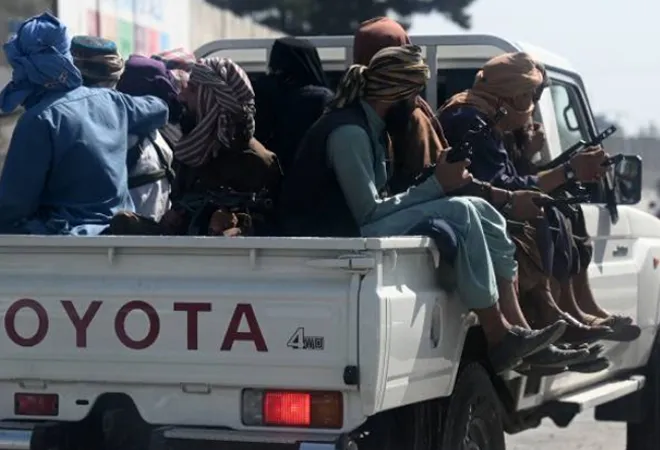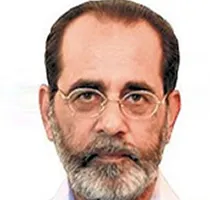-
CENTRES
Progammes & Centres
Location

There is an old saying – Be careful what you wish for….China, Russia, Iran and Pakistan were the most vociferous in demanding the exit of the c(US) from Afghanistan. Now that images of people hanging on to a C-17 Globemaster, as it taxis for take-off evoking parallels with the fall of Saigon in April 1975 have been seen with smug satisfaction in Islamabad, Tehran, Beijing and Moscow, a grim reality is seeping in. Chinese Foreign Minister Wang Yi has already expressed his unhappiness at US’ ‘hasty’ exit.
The key question is if there really is a Taliban 2.0 or just a more media savvy repackaged Taliban 1.0 that will create more regional instability. But to unravel that, let us return to how Afghanistan got here.
The demise of the Islamic Republic and return of the Islamic Emirate of Afghanistan became inevitable when in February last year, US Ambassador Zalmay Khalilzad signed an agreement with the Taliban Deputy Leader Mullah Barader in Doha, committing to US withdrawal. While Khalilzad delivered the agreement for the Trump administration, President Joe Biden’s announcement on April 14, 2021 that US would be out before the 9/11 anniversary reaffirmed the unconditional withdrawal.
The US was hoping for a ‘decent interval’ between its exit and the eventual collapse of the Kabul regime but once the Taliban sensed victory, they moved in with an ‘indecent haste’. Despite a domestic backlash against the messy withdrawal, Biden has maintained that his decision was the right one.
The reality is that a cumulative set of mistakes that made US’ continued presence a lightning rod for the insurgency. In 2001, US went into Afghanistan on a counter-terrorism mission, deluded itself that the Taliban had been defeated when they had merely escaped across the border into Pakistan, got distracted with Iraq in 2003, and then got drawn into an increasingly vicious counter-insurgency mounted by the re-energised Taliban.
US had ended its combat operations in 2014 replacing it with a limited ‘train, advise and assist’ mission.
Meanwhile, the narrative about ‘forever wars’ gained traction. The reality is that as Gen Doug Lute said – the US did not fight a 20-year war; it fought a one-year war, 20 times over. In any case, US had ended its combat operations in 2014 replacing it with a limited ‘train, advise and assist’ mission. While 2352 US soldiers were killed between 2001 and 2014, the number of deaths in the following six years was 96. The annual expenditure with its reduced presence was about $45 billion, a small fraction of its $700 billion defence budget.
The real problem was that without removing the sanctuaries in Pakistan, US was caught in a stalemate that made its continued presence unpopular. Its association with a local government that lacked legitimacy and was seen as corrupt and incompetent by the people, added to it.
Pakistan’s strategy paid off when the Doha office opened in 2013, beginning the process of Taliban’s legitimisation, something it had lacked in the 1990s. Changing power equations made Russia and China more wary and critical about US presence in its backyard. Biden is right that delaying the departure would not have changed anything and no astrologer could have found a propitious moment.
Like other countries, India too supported ‘an Afghan-led and Afghan-owned’ peace and reconciliation process. But while other countries did not let this prevent their contacts with the Taliban in Doha and elsewhere, India followed it in letter and spirit. Indian officials did participate in meetings where Taliban were present but refrained from exploring any direct engagement with the Taliban. With the US out and Ashraf Ghani gone, there was no option except to withdraw all diplomatic presence, closing the embassy for all practical purposes.
While no one knows if Taliban have changed, they will find that Afghanistan has changed in the last twenty years. It is a young nation with a median age of 18 and a half years. More than two-thirds of the population is below 30, and this cohort has grown up in a conservative but open society; 60 percent of the population enjoy internet access. They, along with women, minorities will resist a return to the Islamic Emirate of the 1990s.
More than two-thirds of the population is below 30, and this cohort has grown up in a conservative but open society; 60 percent of the population enjoy internet access.
Further, Taliban today is not a unified entity. Mullah Barader is a co-founder of the Taliban and Mullah Omar was his brother-in-law. He was taken into custody by the ISI in 2010 to punish him for being in direct contact with President Hamid Karzai. Eight years in ISI custody are unlikely to have left him with happy memories. The Doha negotiators constitute the public face but the fighting has been done by local commanders on the ground. Quetta shura is headed by a cleric Mullah Haibatullah Akhundzada and two deputies, Mullah Yaqub, son of Mullah Omar who has been overseeing military operations in the south and Sirajuddin Haqqani who heads the Haqqani network, operating in the east. There are other groups too – Al Qaeda, IS -Khorasan, Uighurs (ETIM), Uzbeks (IMU), Tajiks (Khatiba Imam al Bukhari) and Pakistani groups like the TTP, LeT, JeM, Jamaat ul Ahraar, Lashkar-e-Islam and Lashkar-e-Jhangvi. All of them have linkages with Taliban fighters on the ground but power sharing negotiations may end up pitching them on opposite sides.
Another chapter in Afghanistan’s political transition that began with the coup in 1973, has ended and at present, India has little choice except to wait and watch because unlike the West, we remain part of the region.
This commentary originally appeared in Hindustan Times.
The views expressed above belong to the author(s). ORF research and analyses now available on Telegram! Click here to access our curated content — blogs, longforms and interviews.

Ambassador Rakesh Sood was a Distinguished Fellow at ORF. He has over 38 years of experience in the field of foreign affairs economic diplomacy and ...
Read More +